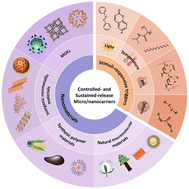Recent advances in the design of controlled- and sustained-release micro/nanocarriers of pesticide
Abstract
To meet the increasing demand for food, pesticides must be overused to protect crops from pests and diseases. However, the chronic use of excessive pesticides poses a risk to human health and the ecological environment. This situation increases the urgency of developing controlled- and sustained-release micro/nanocarriers with the ability to improve pesticide targeting, prevent premature release of pesticides and exhibit low toxic side effects. This review summarizes the recent progress in the design of nanomaterials as micro/nanocarriers with a particular emphasis on their advances, challenges and future improvements in pesticide applications in recent years. Firstly, the common stimuli-responsive triggers and the stimuli-responsive switches that control the release of pesticidal active ingredients (AIs) from micro/nanocarriers are summarized. Moreover, how nanomaterials such as metal–organic frameworks (MOFs), inorganic non-metallic materials, synthetic polymer materials and natural polymer materials are designed as pesticide carriers is reviewed. Finally, the current problems and future development directions of controlled- and sustained-release micro/nanocarriers are put forward.

- This article is part of the themed collections: Environmental Science: Nano Recent Review Articles, Environmental Science: Nano Recent HOT Articles and Outstanding Papers 2023 – Environmental Science: Nano


 Please wait while we load your content...
Please wait while we load your content...